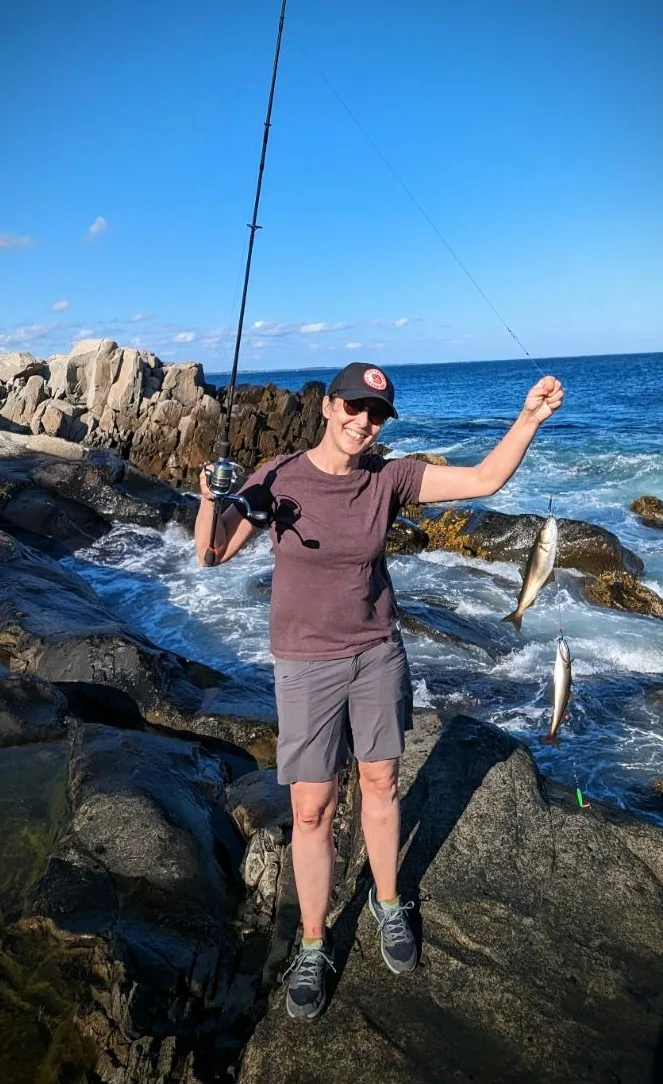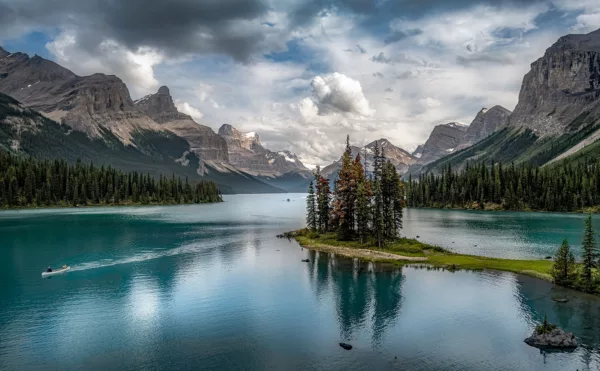A Micro Misadventure Fishing in Nova Scotia

Pulling myself into a seated position on a mound of jagged rocks, I quickly discovered a gaping wound across the top of my right knee. I winced in pain and embarrassment as my fishing companions approached me with awkward expressions of shock and pity. They assured me that I was okay, and that it was “just a scrape.”
“I dunno,” I said, examining my injury, “is that bone?”
My family and I were renting a vacation cottage on Nova Scotia’s south shore. The day we arrived, the property owner offered to take me fishing sometime during our week-long visit. I was thrilled. But as our week drew to a close without an invitation, I prepared myself for disappointment. Finally, on the last night of our trip, the tides were perfect for fishing and the owner invited me to tag along. I hesitated at first, as friends were joining us that evening and we hadn’t seen them in five years, but it was too good of an offer to pass up. I was eager to check East Coast fishing off my vacation bucket list. So I agreed to go, and invited one of my friends to come along.

We loaded up into a car with a bundle of rods and instructions to mind the hooks that dangled around as we bounced down the gravel road. My stomach lurched as we turned down a familiar path leading to the ocean; surely we were not headed to the same hiking trail and rocky point I had visited with my family earlier in the week! I spent the majority of that hike begging my kids to stay on the trail and away from the water’s edge. The rugged shoreline was stacked with jagged boulders, slippery from unpredictable waves that crashed against them in vertical walls of cold, frothy spray. “Just the type of place where a tourist disappears without a trace,” I muttered to my husband, while pulling the kids back to the trail.
But here we were—back in the same place. Just go with it, I told myself. You wanted an East Coast adventure!
We unloaded the car and started down towards the water. I was barely out of the parking lot and nowhere near the most treacherous part of the shoreline when I rolled my ankle and went down hard and fast with an armful of fishing rods and nothing but my kneecap to break the fall. I didn’t even know it was happening until I was face down on the rocks.
In pain and disbelief, I was determined to salvage whatever I could from this outing. After confirming I could stand, I vowed to forget about my knee and get on with it. It would need to be cleaned and probably needed stitches, but it wasn’t bleeding much, so I decided it could wait an hour. We could salvage this! I pulled myself to my feet, handed the rods back to our guide, and cautiously hobbled across the rocks to our fishing spot.
“Don’t step on the black rocks,” our guide shouted over his shoulder as we stood atop a ledge overlooking the churning water and slippery rocks below. As a lifelong prairie kid, I was terrified to venture close to the waves that pummelled the shore and I could not afford another misstep. Once we’d arrived, I positioned myself on a patch of dry rocks and propped my body against a boulder for stability. A fishing rod was thrust into my hands, with brisk instructions to cast it out as far as I could. Despite the pain and awkward casting position, within a couple of minutes, we were hauling fresh Atlantic pollock out of the surf two at a time—quickly filling a bucket to bring home for dinner. Success!

It wasn’t until we returned to our cottage that I admitted the extent of my injuries. Medical attention would be ideal, but it was not close by, so I cleaned the wound in the bathtub and opted to forgo stitches in favour of eating freshly grilled fish on the beach with my friends—a decision I do not regret.
The experience is now permanently scribed on my body with a long purple scar and an unsightly knee cap deformity. An adventure travel memento, of sorts. In the weeks that followed, other, less visible scars began to emerge—the kind that shape your memories, thoughts and emotions once you’ve had time to process an experience.
When I told my sister that I injured myself in Nova Scotia, her response was, “Please tell me you didn’t fall on the rocks when you went fishing!” Sheepishly, I confessed. You see, three years ago, our father suffered serious injuries after falling on rocks while fishing in British Columbia. He spent several weeks in the hospital, and, for a time, we were unsure if he would ever live independently again. His mobility has not been the same since the accident, and though he is an avid outdoorsman, he no longer ventures far from home.
The moments we realize we are just like our parents are not always easy to swallow. This one got to me, and it instilled an instant fear of losing my ability to do the things that I love most. Camping, fishing, paddling and exploring outdoors bring me the deepest joy and are central to my identity. If a minor injury could send me spiraling this way, I questioned how I would adapt to my inevitable physical decline in later stages of life. At 42, I hope to have decades of outdoor adventures ahead of me. This experience forced me to consider what this might look like through different stages of life. It can all change so fast. Or so slowly you don’t even notice it happening.

As the mother of two young kids, I have only recently emerged from the fog of early parenthood and regained the capacity to pursue my outdoor passions more regularly. This includes fly fishing and spending as much time as possible exploring remote trout streams in the foothills of Alberta. Not exactly an extreme sport, though crossing swift water with slippery rocks comes with its own risks—particularly for falls. My accident prompted me to consider what strategies I could put in place to ensure my adventures can continue into old age.
First, I have prioritized strength and mobility training. Strength training is particularly important for women as we age. Maintaining flexibility, balance and reaction time is critical to navigating challenging terrain on land and in the water. Second, I have traded my riverside flip-flops and slippery wading boots for sturdy shoes and studded boots—fashion be damned! I’ll also be using a wading staff for any future river crossings. Lastly, I’ve added a waterproof satellite communication device to all of my off-grid adventures. It brings peace of mind knowing I can get help if I need it, and that my family can reach me in case of an emergency at home.
Taking a few simple steps to improve my outdoor safety practices has helped me calm some of the fears that crept up after my accident. If you are banking on a lifetime of outdoor adventures, it would serve you well to periodically reevaluate your practices to ensure you can continue to engage in the things that bring you joy outdoors for as long as possible.
At the very least, stay away from the black rocks!















